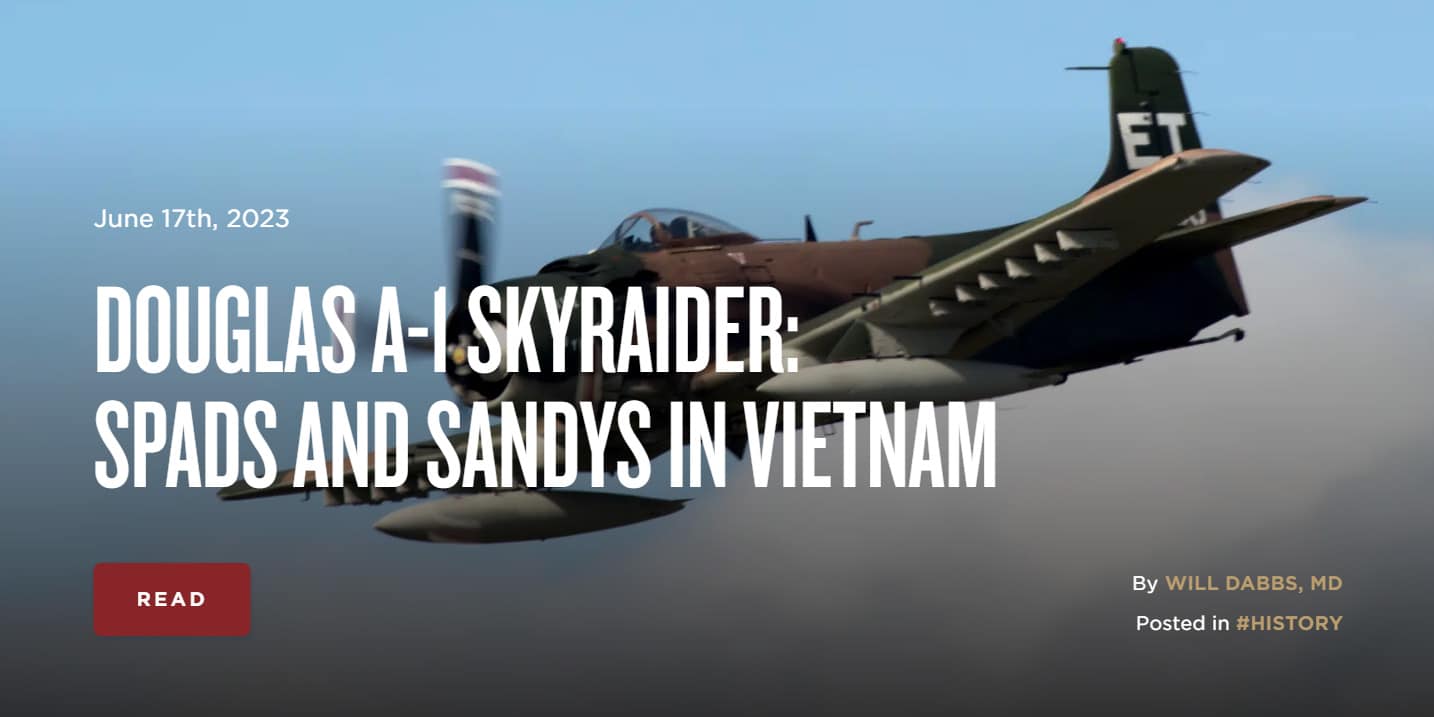Hello all, here is today's article posted on TheArmoryLife.com. It is titled “Douglas A-1 Skyraider: Spads and Sandys in Vietnam” and can be found at https://www.thearmorylife.com/douglas-a-1-skyraider/.



The downed pilot Fisher rescued was Major "Jump" Myers who, when I was a kid, lived across the lake from our place. Next door to Jump was Dad's co-worker so we would go over and visit with both and had some some good times. Jump had a large painting depicting the rescue hanging over his fireplace. This was the original reproduced for the article in The Readers Digest which I think published in the 60s. The article sure brought back some fond memories.There was at least one more instance of an A-1 pilot receiving the Medal of Honor. While under heavy enemy fire, USAF pilot Bernard F. Fisher landed his A-1 and loaded a downed pilot aboard. Here is Fisher's MoH Citation:
For conspicuous gallantry and intrepidity at the risk of his life above and beyond the call of duty. On that date, the special forces camp at A Shau was under attack by 2,000 North Vietnamese Army regulars. Hostile troops had positioned themselves between the airstrip and the camp. Other hostile troops had surrounded the camp and were continuously raking it with automatic weapons fire from the surrounding hills. The tops of the 1,500-foot hills were obscured by an 800 foot ceiling, limiting aircraft maneuverability and forcing pilots to operate within range of hostile gun positions, which often were able to fire down on the attacking aircraft. During the battle, Maj. Fisher observed a fellow airman crash land on the battle-torn airstrip. In the belief that the downed pilot was seriously injured and in imminent danger of capture, Maj. Fisher announced his intention to land on the airstrip to effect a rescue. Although aware of the extreme danger and likely failure of such an attempt, he elected to continue. Directing his own air cover, he landed his aircraft and taxied almost the full length of the runway, which was littered with battle debris and parts of an exploded aircraft. While effecting a successful rescue of the downed pilot, heavy ground fire was observed, with 19 bullets striking his aircraft. In the face of the withering ground fire, he applied power and gained enough speed to lift-off at the overrun of the airstrip. Maj. Fisher's profound concern for his fellow airman, and at the risk of his life above and beyond the call of duty are in the highest traditions of the U.S. Air Force and reflect great credit upon himself and the Armed Forces of his country.
Thanks for the info! I have asked our tech guy to correct/update the post. Should show changes soon. Thanks for reading, everyone!Pretty good article, but there are some errors in the captions.
The pic captioned:
Pilots of Marine Attack Squadron 331 (VMA-331) train in A-1H (AD-6) Skyraiders over the Atlantic Ocean. Image: U.S.M.C.
...is not right. The aircraft shown is not an A-1H, nor an A-1 of any type. It's an AD-5, which would later (long after the overall Glossy Sea Blue finished was changed to Gull Gray and White) redesignated A-1E.
The pic captioned:
A fire department water truck was used to clean the 6th Special Operations Squadron A-1H Skyraider aircraft at Pleiku Air Base, Republic of Vietnam, 1967. Image: U.S.A.F.
...shows not A-1Hs, but A-1Es (or Gs).
The pic captioned:
U.S. Navy Douglas AD-2 (AH-1) Skyraider attack plane on patrol from USS Boxer (CV-21) in September 1951. The ship was en route to the Korean combat area. Image: NARA
...should not have any reference to "AH-1" in it. Completely different aircraft (Bell Cobra helicopter).
The pic captioned:
During the Korean War, a Skyraider waits to be launched from the port side catapult on the U.S.S. Leyte (CV-42). Also shown are an F4U Corsair and a F5F Panther. Image: NARA
There are two Panthers in the pic, but their designation was F9F, not F5F.
